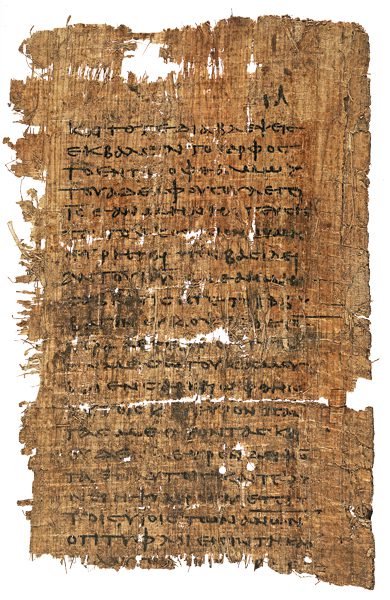This post is part of a series at the Anxious Bench on ‘Contested Ideas in the History of Ideas’, which brings debates from contributors’ respective fields to the fore. Look for more posts in the series throughout the month of October.
In 1945, in Egypt, a long-lost collection of some fifty early Christian gospels and other writings came to light for the first time in some 1400 years. These Nag Hammadi texts aroused real excitement: For a world used to speaking of “gospel truth,” what could be more enthralling than the rediscovery of genuine lost gospels? One of these works in particular, attributed to the apostle Thomas, at least seemed to offer a link to the earliest stages of the faith, and to Jesus himself. This presented an enthralling Jesus who declares that “Whoever is near me is near the fire, and whoever is far from me is far from the kingdom.” For its advocates, Thomas was as old as our canonical gospels, and perhaps even more ancient. Other scholars placed Thomas somewhat later, but everyone agreed that this was a real treasure, a relic of a time when Christianity was more diverse in its views, and perhaps more mystical, than the orthodox church of the Middle Ages.
In my 2015 book The Many Faces of Christ, I challenged what I called the mythology of the lost gospels, the view that they represented any kind of more authentic Christian truth, one suppressed by later institutional bureaucracies. In most cases, I suggested, the lost gospels were far later than our canonical texts, and had no special claim to historical authority. But I also argued that few of those gospels ever had been truly lost, in the sense that the great majority continued to be read and used long after that concealment at Nag Hammadi, around 380 AD. However inconvenient that might be for the attractive myth of a Sacred Truth long hidden but not found, most of those lost gospels enjoyed a long afterlife, and that is even true of the now-venerated Gospel of Thomas. The evidence has always been there for anyone who cares to look for it.
I posted recently on the very long persistence of ancient heretical movements within the Roman/Byzantine world, and especially outside the borders of that realm, where orthodox Christians had no power to enforce their will. Thomas in fact circulated very widely throughout the Middle Ages. (I am drawing all the material that follows from my Many Faces of Christ book, cited earlier).
Even within the Catholic/Orthodox realms, it is far from clear that the churches utterly destroyed the offending alternative gospels. One puzzling piece of evidence comes from the writings of Nicephorus, the ninth-century patriarch of Constantinople. Appended to one of his works is a Stichometry, a list of scriptures known to the church, although not necessarily fully canonical: the document probably dates from the seventh century, but might be later. The fact that each text is listed together with its length suggests that the author had access to complete physical manuscripts, whether that was in a library located in Constantinople or Caesarea or wherever. (I think it’s Caesarea). If that’s true, then someone at the time of writing could still lay hands on a Gospel of Thomas, a Gospel of the Hebrews, as well as many other writings now included among the (orthodox and non-Gnostic) Apostolic Fathers. They knew that the Gospel of Thomas had 1300 lines, and they ranked it right alongside such cherished Church documents as the Didache, the first and second letters of Clement, and the letters of Ignatius and Polycarp, all as part of the New Testament Apocrypha. This is solid company!
It’s not clear how long Thomas circulated in a Catholic/Orthodox context. One cryptic mid-sixth-century list falsely credited to Athanasius lists Thomas alongside other apocryphal works, noting, “By these, quite true and divinely inspired matters have been selected and paraphrased. These are read [anaginoskomena].” In the Eastern churches, that last word is applied to semi-approved texts that are read for instruction or improvement, although they can’t be used to establish doctrine. Thomas is thus listed among the “disputed” books, antilegomena. Even so, it is mind-boggling to think that, somewhere in the Mediterranean world, some orthodox diocese was still happily recommending the Gospel of Thomas to its faithful as late as 550, and who knows how long afterward.
The Gospel of Thomas also became a standard text, perhaps the standard scripture, for the very significant movement of the Manicheans, the world religion founded by Mani in the third century AD. Manichaeism is famous for the absolute and even simplistic distinction that it declared between the forces of Light and Darkness, but in fact, the faith represented a complex synthesis of multiple creeds, including Zoroastrianism, Buddhism, and Christianity (particularly Jewish Christianity, and Gnosticism). Mani’s parents actually belonged to a Jewish-Christan baptismal sect, and that tradition probably explains the appeal of Thomas. At its height, the movement flourished from France to China, and it persisted until at least the end of the seventeenth century. It was very strong in Central Asia, in the world of the Silk Route, and that role probably explains the fragments of Thomas that we possess, in the Parthian and Sogdian languages, from the oasis of Turfan, in northern China. These date from the eighth and ninth centuries.
When early church Fathers referred to the Gospel of Thomas, it was usually in this Manichaean context. In the sixth century, the Gelasian Decree condemned “the Gospel in the name of Thomas which the Manichaeans use.” In the 720s, John of Damascus denounced the Byzantine Emperor Leo III for his heretical views on images and icons. In John’s opinion, Leo’s views on images rejected matter, just as the Manicheans had done. “The Manicheans followed a gospel according to Thomas, and you will follow that of Leo.” About 870, the anti-Dualist writer Peter of Sicily warned that no one should read the Gospel of Thomas, “for it is not from one of the twelve disciples, but from one of the twelve evil disciples of the Antichrist Mani.” You only forbid someone from reading a book if it is actually available, and if people are tempted to venture into it. Not surprisingly, given the importance of border territories in preserving ideas and writings that had been lost elsewhere, the last probable reference to Thomas as a known and still-read text comes from Armenia about 1285.
The Manicheans influenced other famous heretical sects, such as the Bogomils who flourished in the medieval Balkans. About 1100, a Balkan bishop named Theophylact of Ohrid condemned those who were introducing dangerous new doctrines of the Spirit. Sarcastically, he said that if the heretics could base their evidence on canonical scriptures, he would raise no objection, and would even praise his rivals as public benefactors. But as it was, they were no better than the Manichaioi, Manichaeans, with their heretical Gospel of Thomas. No, he said, anyone who introduces a fifth gospel is thrice accursed! His words only make sense if he knows contemporaries who were not only using Thomas, but treating it as equal to the canonical evangelists. As he was writing in such a cauldron of Bogomil activism, it is reasonable to suggest that those are the “Manichaeans” he is describing. If so, might they even have been reading it in a Slavonic translation? And, we might ask, which other supposedly long-buried scriptures were they actually reading?
Let me stress here that the specific references that we can find to the use of Thomas, or of any non-standard scripture, represent only the tip of a very sizable iceberg. On occasion, and through pure chance, we find some individual or group reading a particular text that is absolutely unexpected, and that seems to come out of nowhere. I once blogged at this site about a medieval heretic leader called Nazarius, an Italian, whom we know in the thirteenth century to have possessed at least one alternative gospel text, and he may have had access to many other Manichean treasures, all of which he received from Bogomil allies. Without that solitary chance reference, we would have no idea of that bizarre covert scriptural universe in which he lived.
What else did Nazarius have on his bookshelves? Or the many other Western heretics like him? Did they have a Gospel of Thomas? Did anyone ever translate it into Latin? It is very probable, but how would we ever know for certain?














